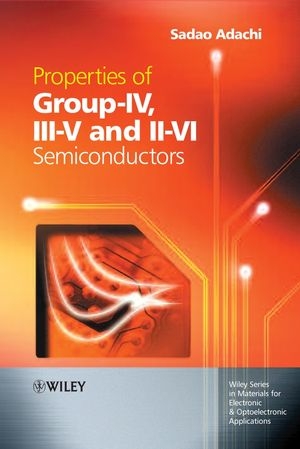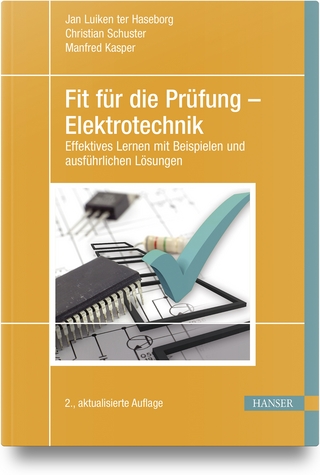
Properties of Group-IV, III-V and II-VI Semiconductors
John Wiley & Sons Inc (Verlag)
978-0-470-09032-9 (ISBN)
Almost all the semiconductors of practical interest are the group-IV, III-V and II-VI semiconductors and the range of technical applications of such semiconductors is extremely wide.
The purpose of this book is twofold:
* to discuss the key properties of the group-IV, III-V and II-VI semiconductors
* to systemize these properties from a solid-state physics aspect
The majority of the text is devoted to the description of the lattice structural, thermal, elastic, lattice dynamic, electronic energy-band structural, optical and carrier transport properties of these semiconductors. Some corrective effects and related properties, such as piezoelectric, elastooptic and electrooptic properties, are also discussed.
The book contains convenient tables summarizing the various material parameters and the definitions of important semiconductor properties. In addition, graphs are included in order to make the information more quantitative and intuitive.
The book is intended not only for semiconductor device engineers, but also physicists and physical chemists, and particularly students specializing in the fields of semiconductor synthesis, crystal growth, semiconductor device physics and technology.
Sadao Adachi is the author of Properties of Group-IV, III-V and II-VI Semiconductors, published by Wiley.
Series Preface. Preface.
Acknowledgements.
1 Structural Properties.
1.1 Ionicity.
1.2 Elemental Isotopic Abundance and Molecular Weight.
1.3 Crystal Structure and Space Group.
1.4 Lattice Constant and Its Related Parameters.
1.5 Structural Phase Transition.
1.6 Cleavage Plane.
2 Thermal Properties.
2.1 Melting Point and Its Related Parameters.
2.2 Specific Heat.
2.3 Debye Temperature.
2.4 Thermal Expansion Coefficient.
2.5 Thermal Conductivity and Diffusivity.
3 Elastic Properties.
3.1 Elastic Constant.
3.2 Third-Order Elastic Constant.
3.3 Young’s Modulus, Poisson’s Ratio and Similar.
3.4 Microhardness.
3.5 Sound Velocity.
4 Lattice Dynamic Properties.
4.1 Phonon Dispersion Relation.
4.2 Phonon Frequency.
4.3 Mode Grüneisen Parameter.
4.4 Phonon Deformation Potential.
5 Collective Effects and Some Response Characteristics.
5.1 Piezoelectric and Electromechanical Constants.
5.2 Fröhlich Coupling Constant.
6 Energy-Band Structure: Energy-Band Gaps.
6.1 Basic Properties.
6.2 E0-Gap Region.
6.3 Higher-Lying Direct Gap.
6.4 Lowest Indirect Gap.
6.5 Conduction-Valley Energy Separation.
6.6 Direct-Indirect-Gap Transition Pressure.
7 Energy-Band Structure: Effective Masses.
7.1 Electron Effective Mass: G Valley.
7.2 Electron Effective Mass: Satellite Valley.
7.3 Hole Effective Mass.
8 Deformation Potentials.
8.1 Intravalley Deformation Potential: G Point.
8.2 Intravalley Deformation Potential: High-Symmetry Points.
8.3 Intervalley Deformation Potential.
9 Electron Affinity and Schottky Barrier Height.
9.1 Electron Affinity.
9.2 Schottky Barrier Height.
10 Optical Properties.
10.1 Summary of Optical Dispersion Relations.
10.2 The Reststrahlen Region.
10.3 At or Near The Fundamental Absorption Edge.
10.4 The Interband Transition Region.
10.5 Free-Carrier Absorption and Related Phenomena.
11 Elastooptic, Electrooptic and Nonlinear Optical Properties
11.1 Elastooptic Effect.
11.2 Linear Electrooptic Constant.
11.3 Quadratic Electrooptic Constant.
11.4 Franz-Keldysh Effect.
11.5 Nonlinear Optical Constant.
12 Carrier Transport Properties.
12.1 Low-Field Mobility: Electrons.
12.2 Low-Field Mobility: Holes.
12.3 High-Field Transport: Electrons.
12.4 High-Field Transport: Holes.
12.5 Minority-Carrier Transport: Electrons in p-Type Materials.
12.6 Minority-Carrier Transport: Holes in n-Type Materials.
12.7 Impact Ionization Coefficient.
Index.
| Erscheint lt. Verlag | 11.2.2005 |
|---|---|
| Reihe/Serie | Wiley Series in Materials for Electronic & Optoelectronic Applications |
| Verlagsort | New York |
| Sprache | englisch |
| Maße | 174 x 253 mm |
| Gewicht | 879 g |
| Themenwelt | Technik ► Elektrotechnik / Energietechnik |
| Technik ► Maschinenbau | |
| ISBN-10 | 0-470-09032-4 / 0470090324 |
| ISBN-13 | 978-0-470-09032-9 / 9780470090329 |
| Zustand | Neuware |
| Haben Sie eine Frage zum Produkt? |
aus dem Bereich


